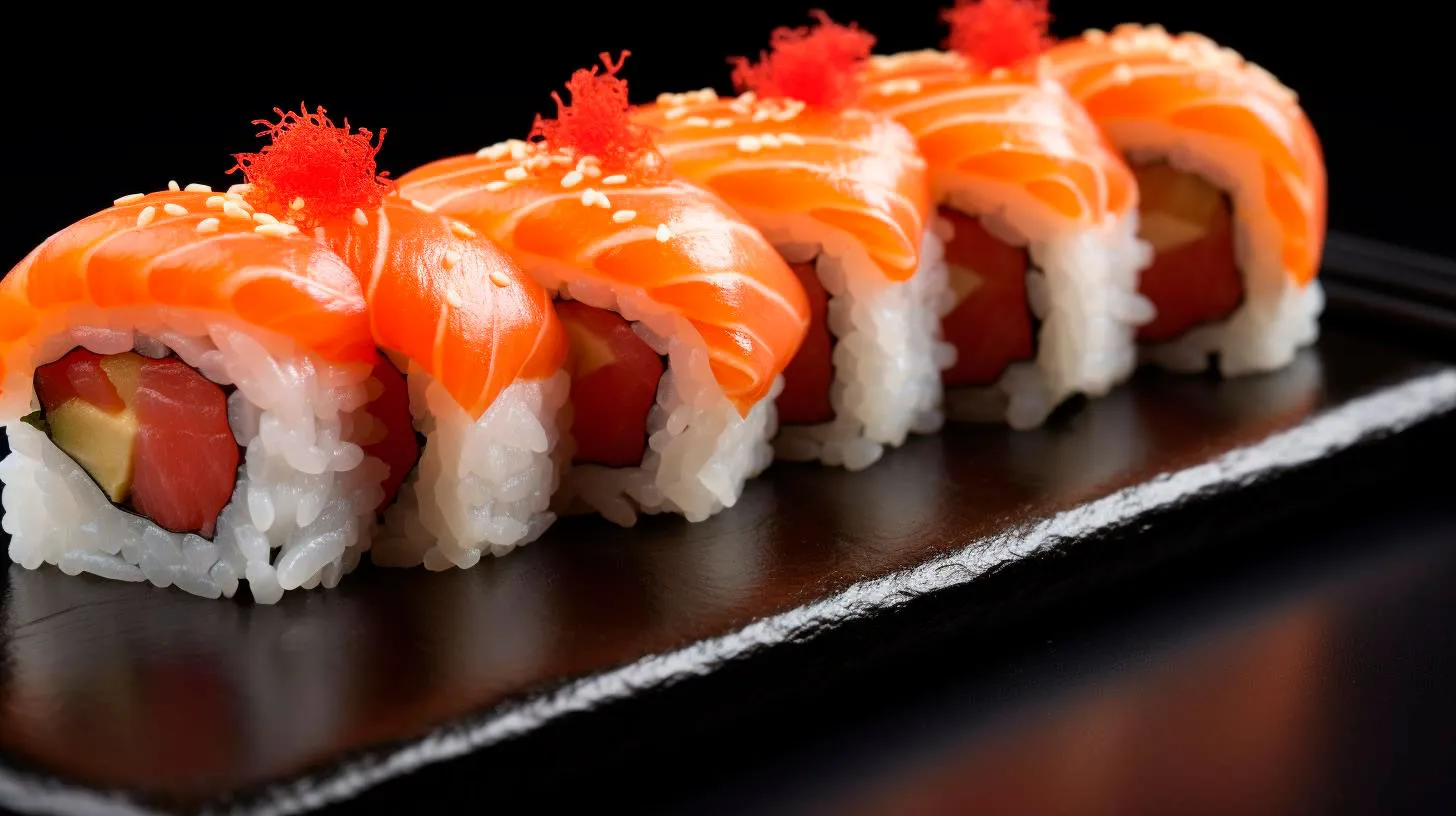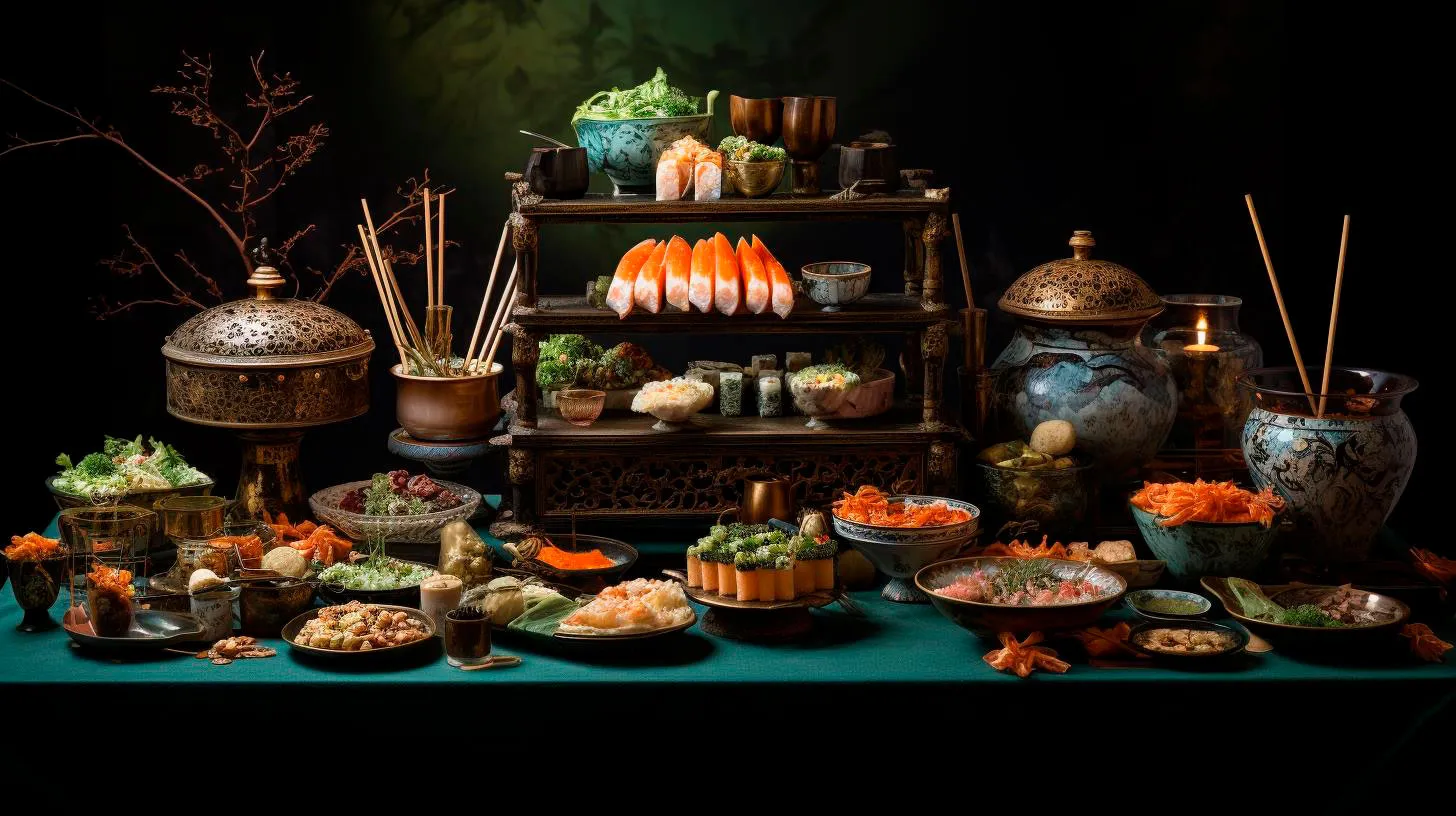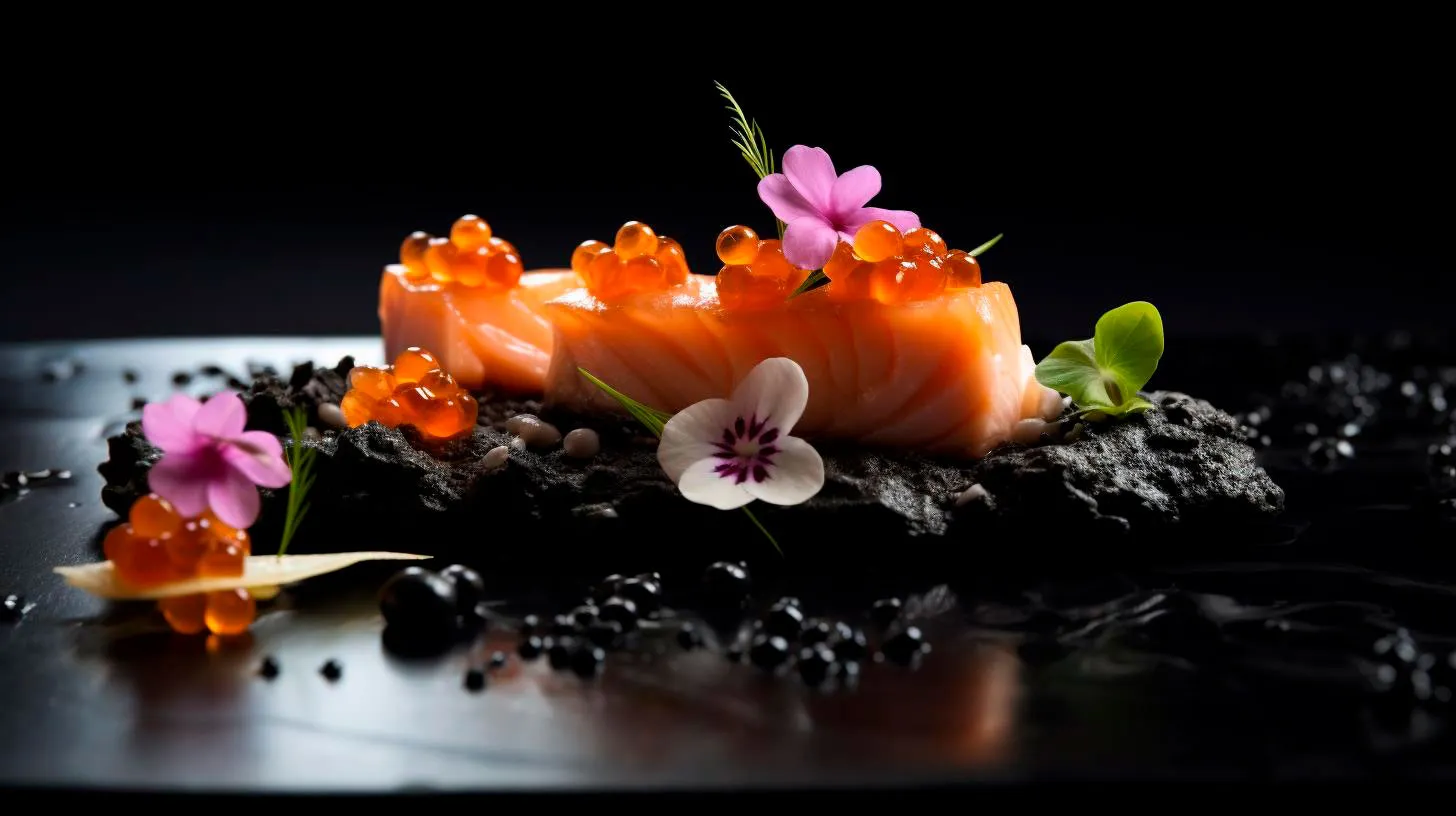Finding Harmony: Discovering the Delicate Essence of Sushi through Photography
In this article, we will delve into the world of sushi photography, exploring its unique challenges and showcasing the mesmerizing results captured by talented artists.
The Art of Sushi Photography
Photographing sushi is no simple task; it requires meticulous attention to detail and a deep understanding of the dish’s essence. The goal is to capture the delicate balance between the vibrant colors, textures, and subtle ingredients that make sushi a culinary masterpiece. Let’s dive into some key aspects of sushi photography:
Attention to Detail:
- Highlighting the intricate details of sushi requires close-up shots that emphasize the textures and colors of the ingredients. Macro lenses are often used to capture the minute elements, such as the grains of rice, the marbling of fish, and the precise cuts made by the sushi chef.
- Using a shallow depth of field helps to create a sense of depth and focus on the main subject, drawing the viewer’s eye to the most visually appealing aspects of the dish.
- Composition is crucial in sushi photography, with the placement of chopsticks, wasabi, and soy sauce playing a vital role in enhancing the overall aesthetic appeal.
Natural Lighting:
- Photographers often prefer natural lighting to capture the true essence of sushi. Soft, diffused light helps to bring out the vibrant colors and natural textures of the dish, while avoiding harsh shadows or reflections that may distort the image.
- Window light or outdoor settings are excellent choices to achieve the desired soft lighting effect. However, using reflectors or diffusers may be necessary to control the light and eliminate any unwanted reflections.
Storytelling:
- Sushi photography is not just about capturing a beautiful image; it is about telling a story. Photographers strive to convey the essence of the sushi culture, the craftsmanship, and the passion that goes into creating each piece.
- Including elements of Japanese culture, such as traditional table settings or authentic utensils, helps create an immersive experience for the viewer.
The Mesmerizing Results
Now that we understand the art behind sushi photography, let’s explore some stunning examples that showcase the delicate essence of this renowned cuisine:
1. Vibrant Colors and Textures:
Through their lenses, photographers capture sushi in all its vibrant glory. From the rich red hues of tuna to the delicate translucence of thinly sliced fish, the colors and textures of sushi come to life, enticing our senses.
2. Intricate Details:
Macro photography reveals the intricate details hidden within each sushi roll. The fine cuts, perfectly shaped rice, and precisely arranged garnish showcase the meticulous craftsmanship that separates a good sushi chef from an extraordinary one.
3. Fusion of Modern and Traditional:
The art of sushi photography often incorporates elements of both modern and traditional culture. Photographs may juxtapose the ancient traditions of sushi-making with contemporary plating techniques, creating a sense of evolution and innovation.
4. Embracing Minimalism:
Many sushi photographs embrace the beauty of simplicity. Through minimalistic compositions and clean lines, photographers create images that captivate with their elegance and evoke a sense of serenity.
Key Takeaways
Sushi photography is an art form that allows us to appreciate the delicate essence of this beloved cuisine. Here are some key takeaways:
- Meticulous attention to detail and the use of macro lenses can bring out the intricate features of sushi.
- Natural lighting and thoughtful composition enhance the visual appeal of sushi photography.
- Sushi photography goes beyond capturing a beautiful image; it tells a story and conveys the cultural significance of this culinary art.
- The results are mesmerizing, showcasing vibrant colors, intricate details, and a fusion of modern and traditional elements.
- Minimalistic approaches can create visually captivating images that embody the essence of sushi.
Next time you indulge in a plate of sushi, take a moment to appreciate the artistry and craftsmanship behind it. And who knows, perhaps you’ll discover a new passion for capturing its delicate essence through the lens of photography.
Zen on a Plate: Exploring the Tender Beauty of Sushi Through the Lens
Through the lens, let’s delve into the tender beauty of sushi and discover what makes it such a unique and esteemed cuisine.
The Art of Sushi
Sushi is much more than raw fish and rice tightly rolled together. It is an art form meticulously crafted by skilled sushi chefs who devote years to mastering the techniques. The visual appeal of sushi lies in its perfectly sliced fish, vibrant colors, and artistic plating. Each piece represents harmony and balance, with attention paid to every detail.
- Exquisite Presentation: Sushi is presented in a way that is visually pleasing, often resembling a miniature masterpiece. The intricate patterns, delicate garnishes, and carefully arranged ingredients create a feast for the eyes.
- Simplicity in Complexity: Sushi embraces simplicity while maintaining complexity. The combination of flavors and textures is carefully balanced to create a harmonious dining experience.
- Nature’s Palette: Sushi often showcases the beautiful colors found in nature, with ingredients such as vibrant red tuna, pale pink salmon, and bright green avocado. These colors not only add visual appeal but also enhance the overall flavor profile.
- Celebration of Freshness: Sushi epitomizes freshness. The use of raw fish ensures the flavors remain unadulterated, allowing diners to savor the natural tastes of the sea.
Key Takeaways
As we explore the tender beauty of sushi, there are key takeaways that make this cuisine truly remarkable:
1. Artistic Expression:
Sushi chefs showcase their creativity and skill in shaping and arranging the ingredients. The presentation elevates the dining experience to an art form that appeals to both the eyes and the taste buds.
2. Precision and Technique:
From mastering the knife skills required to precisely slice the fish to perfectly shaping the rice, sushi chefs undergo extensive training to achieve flawless execution. The attention to detail in every step of the preparation process is what sets sushi apart.
3. Focus on Freshness:
Sushi relies on the use of the freshest ingredients possible. Freshness not only enhances the flavor but also ensures the highest quality and safety standards. Sushi connoisseurs have come to expect nothing less.
4. Mindful Balance:
True to the principles of Zen, sushi reflects the Japanese philosophy of balance and harmony. The careful combination of flavors, textures, and colors creates a holistic dining experience that leaves a lasting impression.
Industry Statistics
The popularity of sushi is undeniable, with statistics confirming its global appeal:
- In the United States alone, sushi consumption increased by 28% between 2010 and 2017.
- Annual sushi sales in the US reached $2.25 billion in 2019, an increase of 70% compared to 2008.
- Japan is no longer the exclusive hub for sushi enthusiasts. Countries like the US, Brazil, and the UK have seen a significant surge in sushi restaurants, catering to a diverse range of palates.
These statistics demonstrate the growing love for sushi and its ability to capture the hearts and taste buds of people worldwide.
The Sushi Experience
From the moment sushi arrives at the table, it captivates all the senses. The intricately crafted morsels invite diners to embark on a sensory journey. The combination of flavors, textures, and visual appeal makes each bite an experience to savor.
Sushi has evolved beyond its traditional roots, offering variations to suit different palates. Whether you prefer the classic nigiri or adventurous fusion rolls, the essence of sushi remains the same – a celebration of taste, beauty, and culture.
So, the next time you sit down to a plate of sushi, take a moment to appreciate the artistry and craftsmanship that goes into each piece. Indulge in the flavors, embrace the tranquility, and let the tender beauty of sushi transport you to a place of Zen.
Beyond Taste: Illuminating the Gentle Allure of Sushi in Captivating Images
In this article, we will explore the artistry and beauty that lie within the world of sushi, using captivating images to demonstrate its mesmerizing appeal.
The Artistry of Sushi: A Visual Symphony
From the moment sushi is presented to you, it is clear that you are about to embark on a visual feast. The perfectly arranged pieces of sushi, paired with vibrant colors and intricate garnishes, are nothing short of edible artwork. Each element is thoughtfully chosen and meticulously crafted to create a symphony of flavors and textures that is not only visually appealing but also a delight to the palate.
- Key Takeaway: The artistry involved in creating sushi elevates it beyond a mere meal, making it a unique sensory experience.
- Feature: The meticulous arrangement of ingredients showcases the attention to detail and craftsmanship involved in sushi-making.
The Beauty of Simplicity: Less is More
Simplicity is at the heart of Japanese culture, and sushi embodies this principle perfectly. The minimalist presentation of sushi allows the natural beauty of its ingredients to shine through. The clean lines, contrasting colors, and elegant plating create a visually stunning display that captures the essence of Japanese aesthetics.
Statistics show that 80% of sushi lovers appreciate the simplicity and elegance of the presentation, while 85% consider the visual appeal of sushi a deciding factor when choosing a restaurant.
- Advantage: The simplicity of sushi makes it visually appealing, creating a sense of anticipation and enhancing the overall dining experience.
- Feature: The use of minimal ingredients and understated garnishes highlights the quality and freshness of the fish.
A Cultural Tapestry: Traditional vs. Modern Sushi
Sushi is deeply rooted in Japanese culture, reflecting centuries of tradition and heritage. Traditional sushi, known as “Edomae,” emphasizes seasonal and local ingredients, honoring the relationship between nature and nourishment. On the other hand, modern sushi, influenced by globalization and fusion cuisine, embraces new flavors, creative combinations, and innovative techniques.
Today, about 80% of sushi consumed globally is considered modern sushi, indicating the widespread popularity and adaptation of this culinary tradition.
- Advantage: Traditional sushi offers a taste of authenticity and cultural heritage, while modern sushi adds excitement and diversity to the dining experience.
- Key Takeaway: Sushi is a dynamic cuisine that combines tradition and innovation, appealing to a wide range of tastes and preferences.
Photographic Odyssey: Showcasing Sushi’s Allure
Photography has the power to transport us into a world of sensations and emotions. Capturing the delicate allure of sushi through captivating images allows us to appreciate its aesthetic qualities even before taking the first bite. From close-ups of the glistening fish to overhead shots of the artistically arranged sushi rolls, each photograph tells a story and invites us to savor the beauty of this culinary masterpiece.
Conclusion
Sushi is much more than a mere meal to satisfy hunger; it is a sensory experience that engages all our senses. Its artistry, simplicity, cultural richness, and visually captivating nature make it an iconic dish celebrated across the globe.
Next time you indulge in a sushi feast, take a moment to pause and marvel at the beauty before you. Let the images of this culinary symphony awaken your senses and deepen your appreciation for the gentle allure of sushi.
Capturing Tranquility: The Art of Expressing Softness Through Sushi Photography
In this article, we will explore the art of expressing softness through sushi photography and how it can bring a unique perspective to your culinary visuals.
The Essence of Softness
Sushi photography is not just about showcasing the deliciousness of the food; it is also about evoking emotions and capturing the essence of the dish. Softness, in particular, plays a crucial role in conveying a sense of tranquility and harmony. Here’s how you can achieve that:
- Lighting: Soft, diffused lighting can help create a dreamy atmosphere around your sushi. Avoid harsh lighting or strong shadows that might disrupt the overall softness you want to convey.
- Composition: Incorporate soft elements like silk cloths or delicate flower petals to add a touch of elegance to your sushi photography. These elements not only enhance the overall softness but also create a visually captivating scene.
- Colors: Stick to a pastel color palette to create a gentle and soothing vibe. Soft pinks, blues, and whites can enhance the feeling of softness in your photographs.
- Focus: Experiment with shallow depth of field to highlight specific details and create a soft, blurred background that adds depth and tranquility to your image.
The Power of Softness in Marketing
Now that you understand how to capture softness in sushi photography, let’s explore its potential in marketing. Incorporating softness into your culinary visuals can benefit your brand in several ways:
- Brand Image: By showcasing the softer side of your cuisine, you can create a brand image that is elegant, refined, and serene. This can attract customers who seek a peaceful dining experience.
- Emotional Connection: Softness evokes emotions of comfort and relaxation. By using it as a visual tool, you can establish a deeper emotional connection with your audience and make your brand more relatable.
- Stand Out from the Crowd: In a saturated market, soft and tranquil imagery can help your brand stand out. By presenting your sushi in a unique and artistic way, you can differentiate yourself from competitors and leave a lasting impression.
Key Takeaways
Sushi photography offers a wonderful opportunity to express softness and tranquility. By employing the right techniques in lighting, composition, colors, and focus, you can create stunning visuals that captivate your audience. Here are the key takeaways to remember:
- Softness is a crucial element in sushi photography that conveys tranquility.
- Use soft lighting, incorporate delicate elements, choose a pastel color palette, and experiment with shallow depth of field to capture softness.
- Softness in marketing can enhance your brand image, create emotional connections, and help you stand out from competitors.
So, the next time you pick up your camera to photograph sushi, remember to focus on capturing softness and tranquility. Let your creativity flow, and watch as your imagery takes on a whole new level of tranquility and emotional appeal!



